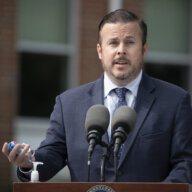 About 8 percent of high school students enrolled in Philadelphia’s school district have experienced homelessness. Credit: Rikard Larma/Metro
About 8 percent of high school students enrolled in Philadelphia’s school district have experienced homelessness. Credit: Rikard Larma/Metro
The incidence of youth homelessness in Philadelphia more than doubled between 2009 and 2011, andat least one out of every 20 high school students enrolled in the School District of Philadelphia has experienced homelessness or abandonment, been kicked out of their residence or has run away,according to a study released last month by the social services nonprofit People’s Emergency Center.
The study, Homeless Youth in Philadelphia, analyzed data shared by Philadelphia public high school students with the U.S. Department of Health and Human Services’ Youth Risk Behavior Survey, which uses a variety of polling methods to measure the health and habits of children in grades 9 through 12.
The city of Philadelphia between 2008 and 2011 reported an increase of 339 percent in overall demand for family emergency housing, and officials in 2012 estimated about one-third of the demand for such shelter went unmet, according to the study.
The report shows the percentage of Philadelphia youth who reported sleeping away from home with a parent more than doubled between 2009 and 2011, while the percentage of young people reporting they typically slept away from home without a parent more than tripled during the same time.
Almost 11 percent of students reported they’d been kicked out of their homes, abandoned or had run away – another metric that more than doubled between 2009 and 2011.
In all, about eight percent of all Philadelphia public high school students reported having experienced homelessness.
According to the report, homelessness puts youth at a disproportionately higher risk than their peers to drop out of high school and have substance abuse problems, as well as engage in physically, mentally and sexually risky behavior.
Youth who are homeless with their families were 2.6 times more likely than their peers to report having been forced to have sex, more than three times more likely to have gotten pregnant and three times more likely to have attempted suicide, the data shows.
The People’s Emergency Center is strongly urging that the national Youth Risk Behavior Survey add housing questions to gather more complete information on youth homelessness so the government can allocate the proper resources.
The group further supplemented the Youth Risk Behavior Survey with its own series of stakeholder interviews to better understand the data’s implications and suggest ways they can be used to inform policies addressing the needs of homeless youth.
The People’s Emergency Center also proposed measures the city of Philadelphia could take to improve youth homelessness, including creating more safe places for teens by making available community centers and extending the use of school buildings after hours, developing a collaborative strategy to connect students with social services through the employment of community leaders, students and their families, increasing interdepartmental communication between schools and various social services agencies, and placing social workers and psychologists in schools.





























